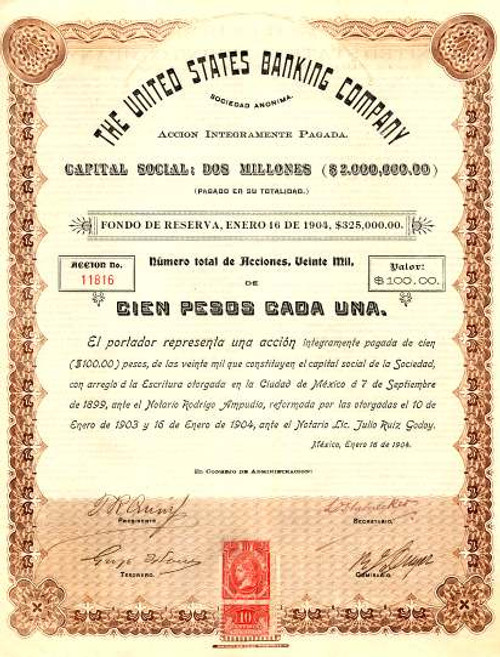Note from the United States Bank Office of Discount and Deposit at New York signed by Samuel Watkinson - Middletown, Connecticut 1802. The First Bank of the United States was a bank chartered by the United States Congress on February 25, 1791. The charter was for 20 years. The Bank was created to handle the financial needs and requirements of the central government of the newly formed United States, which had previously been thirteen individual colonies with their own banks, currencies, and financial institutions and policies. Officially proposed by Alexander Hamilton, Secretary of the Treasury, to the first session of the First Congress in 1790, the concept for the Bank had both its support and origin in and among Northern merchants and more than a few New England state governments. It was, however, eyed with great suspicion by the representatives of the Southern States, whose chief industry, agriculture, did not require centrally concentrated banks, and whose feelings of states' rights and suspicion of Northern motives ran strong. The bank's charter expired in 1811 under President James Madison. In 1816, however, Madison revived it in the form of the Second Bank of the United States.
Samuel Watkinson, Sr. (1745-1816) was born in Sible Hedingham, Essex, England and married Sarah Blair (1743-1819) of Giffordland Dalry, Ayshire, Scotland on 1766. The couple settled in Lavenham, Suffolk, England, where their 12 children were born: Mary Watkinson Perkins (1769-1840), Sarah Watkinson Pledger (1770-1830), John Revell Watkinson (1772-1850), Samuel Watkinson, Jr. (1773-1798), Elisabeth Watkinson Collins (1775-1828), Richard Watkinson (1776-1798), David Watkinson (1778-1857), William Watkinson (1779-1852), Anne Watkinson Wells (1781-1836), Edward Watkinson (1783-1859), Jane Watkinson Gill (1785-1859), and Robert Watkinson (1786-1867). Samuel Watkinson, Sr. was a master woolcomber, and the family was wealthy. During the time of the French Revolution, Toryism made it difficult for the Watkinsons as members of a nonconformist church, who were looked upon as the friends of liberty, to continue to live in England. In 1795, the whole family immigrated to the United States and settled in Middletown, Connecticut. The male family members soon became active in business. Samuel, Jr., Richard, David, and William left Middletown and ended up working in New York City, when yellow fever broke out in the Middle Atlantic States in 1798. All four were stricken and Samuel, Jr. and Richard died, while David and William were able to recover. See Marian Clarke's David Watkinson's Library and Janet Siskind's Rum and axes: the rise of a Connecticut merchant family, 1795-1850 (Ithaca: Cornell University Press, 2002) for more background information and the unpublished genealogical studies connected with the Watkinson Family Papers for information on later generations of the family. History from Trinity College, Hartford, CT.
Samuel Watkinson, Sr. (1745-1816) was born in Sible Hedingham, Essex, England and married Sarah Blair (1743-1819) of Giffordland Dalry, Ayshire, Scotland on 1766. The couple settled in Lavenham, Suffolk, England, where their 12 children were born: Mary Watkinson Perkins (1769-1840), Sarah Watkinson Pledger (1770-1830), John Revell Watkinson (1772-1850), Samuel Watkinson, Jr. (1773-1798), Elisabeth Watkinson Collins (1775-1828), Richard Watkinson (1776-1798), David Watkinson (1778-1857), William Watkinson (1779-1852), Anne Watkinson Wells (1781-1836), Edward Watkinson (1783-1859), Jane Watkinson Gill (1785-1859), and Robert Watkinson (1786-1867). Samuel Watkinson, Sr. was a master woolcomber, and the family was wealthy. During the time of the French Revolution, Toryism made it difficult for the Watkinsons as members of a nonconformist church, who were looked upon as the friends of liberty, to continue to live in England. In 1795, the whole family immigrated to the United States and settled in Middletown, Connecticut. The male family members soon became active in business. Samuel, Jr., Richard, David, and William left Middletown and ended up working in New York City, when yellow fever broke out in the Middle Atlantic States in 1798. All four were stricken and Samuel, Jr. and Richard died, while David and William were able to recover. See Marian Clarke's David Watkinson's Library and Janet Siskind's Rum and axes: the rise of a Connecticut merchant family, 1795-1850 (Ithaca: Cornell University Press, 2002) for more background information and the unpublished genealogical studies connected with the Watkinson Family Papers for information on later generations of the family. History from Trinity College, Hartford, CT.













